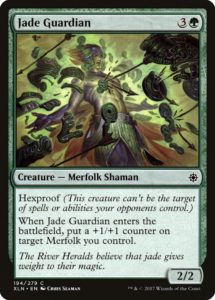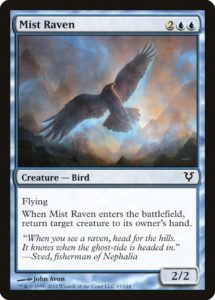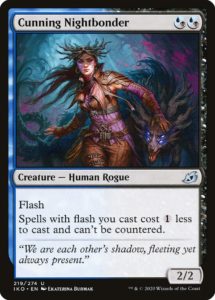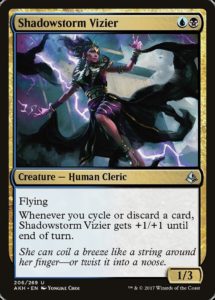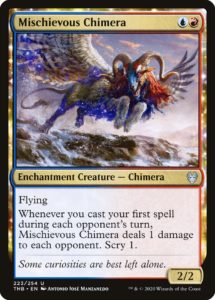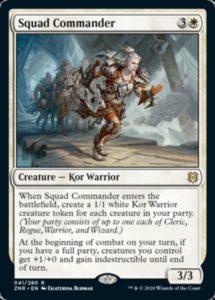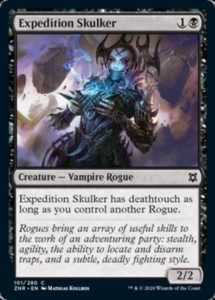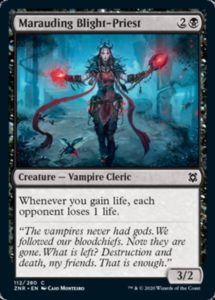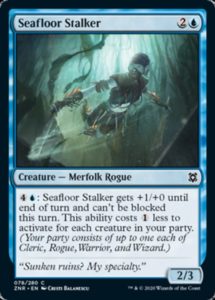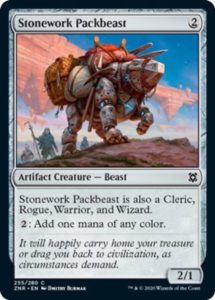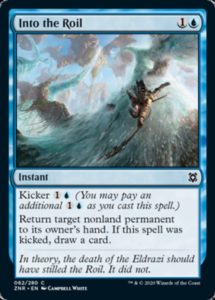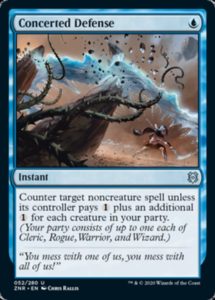The past two years have seen the widespread use of mini-mechanics, leading to very different kinds of Limited formats. Mini-mechanics are unnamed mechanics sprinkled into a set. Where once they only appeared on one to three cards, now entire Limited archetypes each have their own mini-mechanics, such as UR Humans/Non-Humans matter in Ikoria, RW Heroic in Theros Beyond Death, and RWB Knights in Throne of Eldraine. In a moment, we’ll discuss some of the issues mini-mechanics have fared, but the real meat and potatoes of this piece is getting into how Zendikar Rising has largely addressed and perhaps solved those, earning itself serious design (and fun) points.
Major Problem, Mini-Solution?
Original Innistrad created a new standard: all ten color pairs received a multicolor uncommon to serve as a signpost for what its archetype was. This made it clearer for newer drafters to identify what they were doing, and it offered well-defined lanes for players to draft within; but did so at the risk of imposing overly rigid structure upon Limited. If all color pairs have strong, linear themes, then each archetype wants different cards. Card evaluations diverge from archetype to archetype, so while each archetype wants different cards from each other, draft decks of the same archetype will look and play very, very similarly. This was the problem of Lorwyn.
It made sense for Magic to instead structure color pairs around loose themes, rather than overt archetypes. This can make Limited deeper, since color pairs aren’t restricted to primarily doing one thing. Draft pick orders and decks become more dynamic and varied when all colors have access multiple different play styles. Mini-mechanics accomplish this goal by having a lower frequency (there are fewer cards bearing or supporting the mechanic than a major theme) and lower power level ceiling. Compare the ideal BG Reanimator deck in Ikoria with a Throne of Eldraine Adventure deck with multiple copies of Lucky Clover and Edgewall Inkeeper and 15 Adventure creatures.
With looser and weaker mechanics and themes come new challenges, however.
Problem #1: Homogeneity
In trying to reduce homogeneity, loose themes can increase it. When archetypes are overly rigid, they play differently from each other but each deck within that archetype looks and plays mostly the same (reducing replayability, because there are fewer things to explore). When synergies are too weak and mechanics too flexible, synergies don’t draw enough focus. Players instead draft the best generically powerful cards, valuing more cards the same. Decks become weaker (which isn’t bad in and of itself) but also look more similar (which is) because there’s less to distinguish what’s important. Replayability suffers even more because there’s so little to explore. This was the problem of Avacyn Restored.
Interestingly, Ixalan managed to have both Avacyn Restored and Innistrad’s issues. It had relatively few archetypes and weak payoffs (meaning more players evaluated cards the same) while there were nevertheless rigid, linear themes (meaning players had very distinct lanes they had to stay within).
Problem #2: Lack of Direction
Strong themes provide guidance for less experienced drafters, while looser themes provide weaker and harder-to-follow guidance. It’s easier to remember WU Flying in M21 and WB Humans in Ikoria, than it is to explain how UR Humans+Non-Humans is a theme or how to draft it when it’s only on three cards. When these themes are especially muted, you run the risk of creating traps for players by suggesting that an archetype exists when it really doesn’t (such as goblins in Dominaria or Flash-matters in Ikoria).
Problem #3: Aspiration
When there are powerful payoffs for a committed archetype, there’s a high ceiling of what a deck can do. This creates excitement: how many cards you draw off of Secret Plans? How big a swing can you create Adeliz, the Cinder Wind? When payoffs are weaker, there’s less to aspire to. This may be advantageous for Spikes, since eking out a bit of value from Regal Leosaur can mean the difference between winning and losing; but the little cat neither promises much, nor does it even fit well into its color pair.
Problem #4: Permissible Design
The use of mini-mechanics might allow things to sneak into released products that might have been better off on the cutting room floor. We’ve gone into this already, so let’s just say, here’s looking at you, UR in Theros Beyond Death.
As you might have guessed, I have generally not been a fan of mini-mechanics. And then, Zendikar Rising came out and changed my mind despite being full of them. There’s plenty to point to, but nothing does more work than Party.
Party of Nine
Party is the spine connecting Zendikar Rising’s disparate tribal components into a cohesive whole. Tribal sets usually have discrete tribes in discrete color pairs. Each tribe values its own cards higher, leading to drafts defined by linear strategies about getting as much of that tribe (and payoffs for that tribe) as possible. ZNR, however, is a tribal set that pulls in three different directions.
Direction #1: The 4 Tribes
Zendikar Rising sports four traditional tribes with straightforward play patterns: WB Clerics, UR Wizards, RW Warriors, and UB Rogues. Each has cards like Kargan Warleader which reward you for filling your deck with that tribe, while cards like Expedition Healer reward you for having 2+ cards of that type. ZNR has fewer such payoffs than most tribal sets (because there are more directions than just these four), but they serve to provide exclusive lanes for players to commit to with familiar, predictable strategies.
Direction #2: The 4 Mini-Mechanics
All four tribes have a second theme. Each of these themes synergizes with what the class already wants to do—WB Clerics often gain life, UR Wizards encourage playing spells and more wizards, WR Warriors attack better when equipped, and UR rogues mill and/or power up when your opponent has 8+ cards in graveyard—but they are nevertheless a different direction than simply committing hard to one creature type. They make drafting and deckbuilding more nuanced, since some decks will use the tribal mini-mechanic heavily while others might be more linear tribal decks.
On its own, the introduction of tribal mini-mechanics gives some texture to each of the four tribes, but doesn’t really split them into separate archetypes. It’s the last innovation that truly seals the deal.
Direction #3: Cross-Tribal Tribal
Throne of Eldraine introduced negative tribal with nonhuman-matters. Party innovates further by rewarding you for diversifying your creature types, a break from almost every prior tribal mechanic. By restricting you to the four major tribes, it creates convergent card evaluations (where players in different archetypes start competing with each other) despite tribal mechanics creating divergent card evaluations. Party creates an alternative path for every single tribe, where if your WB Clerics deck isn’t quite panning out, you can pivot into WU Party, BR Party, or even something like BG Lifegain/Party where Kazandu Nectarpot enables Marauding Blightpriest. The existence of three different kinds of tribe-focused mechanics, none of which is overly powerful on its own, allows players to mix and match components of each archetype.
The really, really cool thing is that Party functions as an umbrella for nine different mini-mechanics (the four tribes, their four mechanics, and Party, which covers every color pair). It ties all nine together into one coherent package, telling you the set’s main themes while leaving it up to the player whether they want to commit to a tribe, commit to a mechanic, hedge between tribes, or commit to all at once. This is stunningly brilliant design.
Intertribal Glue
Party address the issue of tribal sets being overly constrained; but for it do its job, another problem needed to be solved: there needed to be cross-tribal support. Ixalan exemplified this problem because there were no cards that supported multiple tribes at once. If your UB Pirates wasn’t going well, you couldn’t easily pivot into BW Vampires or GU Merfolk, since your Pirate cards had no synergy with those other tribes. You couldn’t hedge early on—you had to commit a lane and hope for the best. Lorwyn addressed this problem with Changeling, a world-specific mechanic that Zendikar Rising couldn’t repeat—mostly.
Each Zendikar Rising tribe is best in a specific two-color pair but has support in four colors. Warriors work best in red and white, but green and black warriors exist as less-desirable backups when white isn’t available (warriors are primary in red and it’s especially difficult to draft tribe if the primary color isn’t available). Cleric of Chill Depths is mediocre curve-filler, but might provide the crucial cleric for your WU Party deck. These unassuming, generally weaker clerics, rogues, warriors, and wizards exist to be available to off-color tribal decks or Party enablers to all who need them, making it easier to hedge or switch between archetypes. And then, of course, there’s the star of the show.
Stonework Packbast is awesome, and people probably aren’t drafting it highly enough. Yes, its flavor is a bit weirder than Stonework Puma‘s, but it’s high quality support for all tribal and Party cards put onto a barely serviceable set of stats. As an added bonus, it has an absolutely atrocious mana-fixing ability that nevertheless serves a valuable function: Zendikar Rising has especially bad mana-fixing because of Landfall and Modal Double-Faced cards, but Party decks are much easier to play if you have access to three colors. Accordingly, stapling a bad fixing ability onto the most crucial piece of cross-tribal glue makes Stonework Packbeast by itself into a critical component of the set. Not bad for a Bronze Sable.
Modular Everything
Party might be the primary Limited-defining mechanic in Zendikar, but it’s buttressed by multiple flexible mechanics. Kicker and Landfall are all-around good mechanics, and both provide consistency by reducing the pain of mana flood. Modal Doubled-Faced cards reduce mana screw, enable Landfall, and provide another strong, generic option to all decks. Specific colors are better able to use these mechanics (GU has Kicker-matters cards, GW is best at recurring MDFCs, and RG has the most Landfall cards); but the frequency of payoffs is fairly low, more comparable to the support for WBR Knights in Throne of Eldraine or GWU Constellation in Theros Beyond Death than the tribes of Ixalan.
Widespread use of flexible mechanics with minimal (but still relevant) payoffs creates tension in draft and deckbuilding. Every white deck wants Skyclave Cleric (because MDFCs are strong), but WB and GW decks use it best, though for different reasons. Field Research is a fine card, but it’s likely stronger in GU (which wants the Kicker effect and generates more mana) than it is UR (which benefits more from Deliberate being cheaper).
I’ve disliked mini-mechanics in the past for creating minor tensions between archetypes and occasionally creating dud mechanics (looking at you, UR in Theros Beyond Death and UB in Ikoria). Zendikar Rising addresses that problem by employing lots of minor tensions among already strong cards. There are several different ways to get extra value out of your cards, so the choice isn’t whether to go for raw power or synergy—instead, it’s about deciding which synergies to chase among many.
Closing the Gap
Zendikar Rising has the best expression of mini-mechanics ever (in this author’s opinion). But that doesn’t mean it’s a perfect set, nor does Zendikar Rising create a clear path for other sets to follow in its wake. Three color pairs are more awkward than the others: WU and BR are Party-matters (every color pair cares about Party, but these are the only two that have little else to care about) and BG +1/+1 counters (which is about as lightly supported as the other mini-mechanics, but unlike all the others, has limited overlap with anything else). This is likely due to Zendikar Rising not having room for more mechanics and party creating awkward gaps among the color pairs; looking ahead, I wonder whether Strixhaven or Kaldheim will nail all ten.
The success of Zendikar Rising comes from an interconnected web of modular themes, all tied together by the incredible workhorse mechanic of Party, itself a new kind of innovation. For Magic to follow this template, it needs to create more such loose, archetype-crossing mechanics. That’s not an easy task, though I’ve been absolutely blown away by the design work in Zendikar Rising and am excited to see what Wizards comes up with next. Here’s looking forward to learning more of the set and seeing all that follows.
And, as always, thanks for reading.
—Zachary Barash is a New York City-based game designer and the commissioner of Team Draft League. He designs for Kingdom Death: Monster, has a Game Design MFA from the NYU Game Center, and does freelance gatame design. When the stars align, he streams Magic (but the stars align way less often than he’d like).

